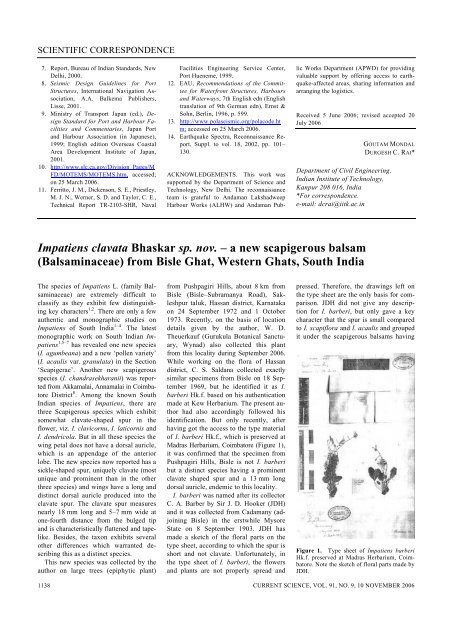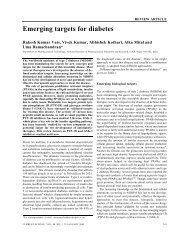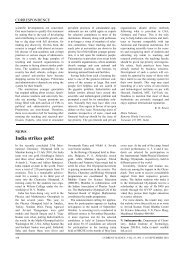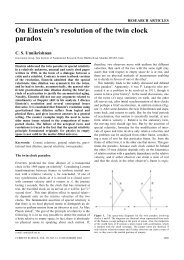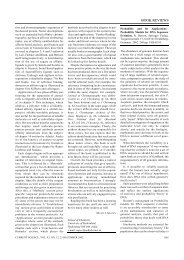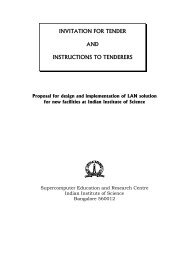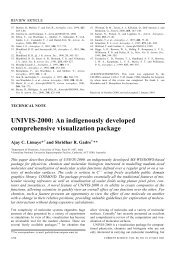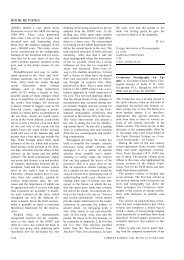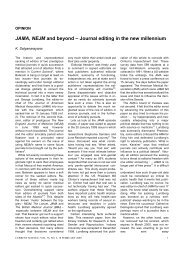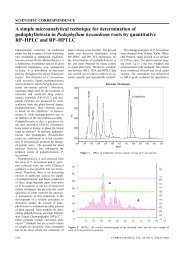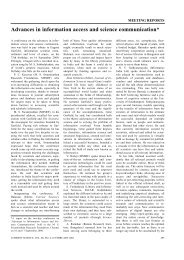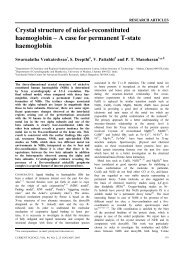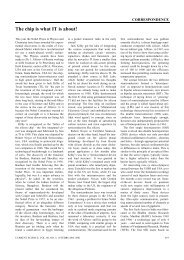Impatiens clavata Bhaskar sp. nov. – a new scapigerous balsam ...
Impatiens clavata Bhaskar sp. nov. – a new scapigerous balsam ...
Impatiens clavata Bhaskar sp. nov. – a new scapigerous balsam ...
You also want an ePaper? Increase the reach of your titles
YUMPU automatically turns print PDFs into web optimized ePapers that Google loves.
SCIENTIFIC CORRESPONDENCE<br />
7. Report, Bureau of Indian Standards, New<br />
Delhi, 2000.<br />
8. Seismic Design Guidelines for Port<br />
Structures, International Navigation Association,<br />
A.A. Balkema Publishers,<br />
Lisse, 2001.<br />
9. Ministry of Tran<strong>sp</strong>ort Japan (ed.), Design<br />
Standard for Port and Harbour Facilities<br />
and Commentaries, Japan Port<br />
and Harbour Association (in Japanese),<br />
1999; English edition Overseas Coastal<br />
Area Development Institute of Japan,<br />
2001.<br />
10. http://www.slc.ca.gov/Division_Pages/M<br />
FD/MOTEMS/MOTEMS.htm, accessed;<br />
on 25 March 2006.<br />
11. Ferritto, J. M., Dickenson, S. E., Priestley,<br />
M. J. N., Werner, S. D. and Taylor, C. E.,<br />
Technical Report TR-2103-SHR, Naval<br />
1138<br />
Facilities Engineering Service Center,<br />
Port Hueneme, 1999.<br />
12. EAU, Recommendations of the Committee<br />
for Waterfront Structures, Harbours<br />
and Waterways, 7th English edn (English<br />
translation of 9th German edn), Ernst &<br />
Sohn, Berlin, 1996, p. 599.<br />
13. http://www.polaseismic.org/polacode.ht<br />
m; accessed on 25 March 2006.<br />
14. Earthquake Spectra, Reconnaissance Report,<br />
Suppl. to vol. 18, 2002, pp. 101<strong>–</strong><br />
130.<br />
ACKNOWLEDGEMENTS. This work was<br />
supported by the Department of Science and<br />
Technology, New Delhi. The reconnaissance<br />
team is grateful to Andaman Lakshadweep<br />
Harbour Works (ALHW) and Andaman Pub-<br />
lic Works Department (APWD) for providing<br />
valuable support by offering access to earthquake-affected<br />
areas, sharing information and<br />
arranging the logistics.<br />
Received 5 June 2006; revised accepted 20<br />
July 2006<br />
GOUTAM MONDAL<br />
DURGESH C. RAI*<br />
Department of Civil Engineering,<br />
Indian Institute of Technology,<br />
Kanpur 208 016, India<br />
*For corre<strong>sp</strong>ondence.<br />
e-mail: dcrai@iitk.ac.in<br />
<strong>Impatiens</strong> <strong>clavata</strong> <strong>Bhaskar</strong> <strong>sp</strong>. <strong>nov</strong>. <strong>–</strong> a <strong>new</strong> <strong>scapigerous</strong> <strong>balsam</strong><br />
(Balsaminaceae) from Bisle Ghat, Western Ghats, South India<br />
The <strong>sp</strong>ecies of <strong>Impatiens</strong> L. (family Balsaminaceae)<br />
are extremely difficult to<br />
classify as they exhibit few distinguishing<br />
key characters 1,2 . There are only a few<br />
authentic and monographic studies on<br />
<strong>Impatiens</strong> of South India 1<strong>–</strong>4 . The latest<br />
monographic work on South Indian <strong>Impatiens</strong><br />
1,5<strong>–</strong>7 has revealed one <strong>new</strong> <strong>sp</strong>ecies<br />
(I. agumbeana) and a <strong>new</strong> ‘pollen variety’<br />
(I. acaulis var. granulata) in the Section<br />
‘Scapigerae’. Another <strong>new</strong> <strong>scapigerous</strong><br />
<strong>sp</strong>ecies (I. chandrasekharanii) was reported<br />
from Akkamalai, Annamalai in Coimbatore<br />
District 8 . Among the known South<br />
Indian <strong>sp</strong>ecies of <strong>Impatiens</strong>, there are<br />
three Scapigerous <strong>sp</strong>ecies which exhibit<br />
somewhat clavate-shaped <strong>sp</strong>ur in the<br />
flower, viz. I. clavicornu, I. laticornis and<br />
I. dendricola. But in all these <strong>sp</strong>ecies the<br />
wing petal does not have a dorsal auricle,<br />
which is an appendage of the anterior<br />
lobe. The <strong>new</strong> <strong>sp</strong>ecies now reported has a<br />
sickle-shaped <strong>sp</strong>ur, uniquely clavate (most<br />
unique and prominent than in the other<br />
three <strong>sp</strong>ecies) and wings have a long and<br />
distinct dorsal auricle produced into the<br />
clavate <strong>sp</strong>ur. The clavate <strong>sp</strong>ur measures<br />
nearly 18 mm long and 5<strong>–</strong>7 mm wide at<br />
one-fourth distance from the bulged tip<br />
and is characteristically flattened and tapelike.<br />
Besides, the taxon exhibits several<br />
other differences which warranted describing<br />
this as a distinct <strong>sp</strong>ecies.<br />
This <strong>new</strong> <strong>sp</strong>ecies was collected by the<br />
author on large trees (epiphytic plant)<br />
from Pushpagiri Hills, about 8 km from<br />
Bisle (Bisle<strong>–</strong>Subramanya Road), Sakleshpur<br />
taluk, Hassan district, Karnataka<br />
on 24 September 1972 and 1 October<br />
1973. Recently, on the basis of location<br />
details given by the author, W. D.<br />
Theuerkauf (Gurukula Botanical Sanctuary,<br />
Wynad) also collected this plant<br />
from this locality during September 2006.<br />
While working on the flora of Hassan<br />
district, C. S. Saldana collected exactly<br />
similar <strong>sp</strong>ecimens from Bisle on 18 September<br />
1969, but he identified it as I.<br />
barberi Hk.f. based on his authentication<br />
made at Kew Herbarium. The present author<br />
had also accordingly followed his<br />
identification. But only recently, after<br />
having got the access to the type material<br />
of I. barberi Hk.f., which is preserved at<br />
Madras Herbarium, Coimbatore (Figure 1),<br />
it was confirmed that the <strong>sp</strong>ecimen from<br />
Pushpagiri Hills, Bisle is not I. barberi<br />
but a distinct <strong>sp</strong>ecies having a prominent<br />
clavate shaped <strong>sp</strong>ur and a 13 mm long<br />
dorsal auricle, endemic to this locality.<br />
I. barberi was named after its collector<br />
C. A. Barber by Sir J. D. Hooker (JDH)<br />
and it was collected from Cadamany (adjoining<br />
Bisle) in the erstwhile Mysore<br />
State on 8 September 1903. JDH has<br />
made a sketch of the floral parts on the<br />
type sheet, according to which the <strong>sp</strong>ur is<br />
short and not clavate. Unfortunately, in<br />
the type sheet of I. barberi, the flowers<br />
and plants are not properly <strong>sp</strong>read and<br />
pressed. Therefore, the drawings left on<br />
the type sheet are the only basis for comparison.<br />
JDH did not give any description<br />
for I. barberi, but only gave a key<br />
character that the <strong>sp</strong>ur is small compared<br />
to I. scapiflora and I. acaulis and grouped<br />
it under the <strong>scapigerous</strong> <strong>balsam</strong>s having<br />
Figure 1. Type sheet of <strong>Impatiens</strong> barberi<br />
Hk.f. preserved at Madras Herbarium, Coimbatore.<br />
Note the sketch of floral parts made by<br />
JDH.<br />
CURRENT SCIENCE, VOL. 91, NO. 9, 10 NOVEMBER 2006
dorsal auricle. Therefore, based on this,<br />
the <strong>sp</strong>ecimen collected by the author from<br />
Pushpagiri Hills, having a long clavate<br />
<strong>sp</strong>ur is proved to be distinct and in no way<br />
related to I. barberi. Hence, it is treated<br />
here as a <strong>new</strong> <strong>sp</strong>ecies and is named I.<br />
<strong>clavata</strong> due to the prominent clavate nature<br />
of the <strong>sp</strong>ur (Figure 2 c).<br />
Table 1 gives the differences between I.<br />
barberi and I. <strong>clavata</strong> <strong>sp</strong>. <strong>nov</strong>.<br />
The complete description of the <strong>new</strong><br />
<strong>sp</strong>ecies is given below:<br />
Section: ‘Scapigerae’<br />
<strong>Impatiens</strong> <strong>clavata</strong> <strong>Bhaskar</strong> <strong>sp</strong>. <strong>nov</strong>.<br />
Epiphytic <strong>scapigerous</strong> tuberous herbs,<br />
perennial, 4<strong>–</strong>5 cm tall, tubers whitish.<br />
Leaves radical, 10<strong>–</strong>15 mm long, petiolate,<br />
lamina ovate, slightly inequilateral, attenuate,<br />
shallowly crenate, apex round, fivenerved,<br />
<strong>sp</strong>arsely pilose above and glabrous<br />
below. Scapes 1<strong>–</strong>3 flowered, up to<br />
4<strong>–</strong>5 cm long, bracts minute, 1.5 mm long;<br />
flowers pink or white, pedicel 10 mm<br />
long, glabrous, sepals three-nerved, equilateral,<br />
furunculate, obtuse at apex; <strong>sp</strong>ur<br />
clavate, 18 mm long, 5<strong>–</strong>7 mm wide at onefourth<br />
distance from the bulged tip, characteristically<br />
ribbon-like, nerves incurved,<br />
reticulate at the bulged tip; standard 3 mm<br />
long; wings three-lobed, anterior lobe with<br />
long (13 mm) dorsal auricle produced<br />
into <strong>sp</strong>ur; posterior lobe elliptic, 18 mm<br />
long, venation open dichotomous. Capsules<br />
ovate, many seeds; seeds brown, hairy<br />
all over the testa, hairs towards the ends<br />
comparatively longer than those at the<br />
lateral sides, bands on hairs <strong>sp</strong>iral.<br />
Affinis ad <strong>sp</strong>eciem I. denisonii, Bedd.,<br />
I. agumbeana <strong>Bhaskar</strong> et Razi, et I. lawsonii<br />
Hk.f., tamen differt calcari clavato<br />
distincto ad 18 mm longo includenti distinctaque<br />
`auricula dorsali’ 13 mm longa.<br />
Typus lectus a Pushpagiri Hills, Bisle<br />
Ghat, Hassan district, Karnataka; 24 September<br />
1971, V. <strong>Bhaskar</strong> 328, positus in<br />
Herb. Mysore University, Manasagangotri,<br />
Mysore.<br />
Among <strong>scapigerous</strong> <strong>sp</strong>ecies of <strong>Impatiens</strong><br />
of South India, there are only three<br />
more <strong>sp</strong>ecies which have a distinct dorsal<br />
auricle produced into the <strong>sp</strong>ur, viz. I.<br />
denisonii Bedd., I. agumbeana <strong>Bhaskar</strong><br />
and Razi and I. lawsonii Hk.f., but I.<br />
<strong>clavata</strong> <strong>sp</strong>. <strong>nov</strong>. differs from these <strong>sp</strong>ecies<br />
in having 18 mm long clavate <strong>sp</strong>ur, 5<strong>–</strong><br />
7 mm wide enclosing a 13 mm long dorsal<br />
auricle. In I. denisonii the <strong>sp</strong>ur is not<br />
clavate and dorsal auricle is not more<br />
than 10 mm long, while in I. agumbeana<br />
and I. lawsonii the <strong>sp</strong>ur is not clavate and<br />
dorsal auricle and <strong>sp</strong>ur are not more than<br />
5 mm long.<br />
Seed characters also differentiate I.<br />
<strong>clavata</strong> from I. denisonii. In the former,<br />
hairs on seeds are filamentous, while in<br />
the latter they are short, and not filamentous.<br />
In both I. <strong>clavata</strong> and I. agumbeana<br />
hairs are elongated at either ends of seeds<br />
(but more dense in I. agumbeana), while<br />
the hairs on the lateral sides are short.<br />
SCIENTIFIC CORRESPONDENCE<br />
The hairs are <strong>sp</strong>irally banded in both the<br />
<strong>sp</strong>ecies.<br />
In addition to these morphological characters,<br />
there are a few similar and dissimilar<br />
micromorphological characters in<br />
these four related <strong>sp</strong>ecies. In I. <strong>clavata</strong><br />
and I. agumbeana, muri on pollen exine<br />
sculpturing has distinct bacules and duplibaculate.<br />
But in I. <strong>clavata</strong>, lumina is irregular<br />
and the processes of the exine are<br />
Table 1. Differences between I. barberi and I. <strong>clavata</strong><br />
I. barberi Hk.f. (Type sheet) (Figure 1) I. <strong>clavata</strong> <strong>Bhaskar</strong> <strong>sp</strong>. <strong>nov</strong>. (Figure 2)<br />
Plant is about 12 cm (dwarf plant compared to Plant is only about 4.5 to 5 cm tall<br />
I. denisonii, according to Hk.f.) (Figure 2 a)<br />
Leaves oblong, about 10 per plant, Leaves 1 to 2 per plant, ovate, petiole<br />
petiole 3.5 cm long about 1 cm<br />
Scapes 4 to 5 per plant, about 12 cm long, Scape single, 4<strong>–</strong>5 cm long, 1<strong>–</strong>3 flowered<br />
more than 4<strong>–</strong>5 flowered per scape per scape (Figure 2 a)<br />
Pedicel about 15 mm long Pedicel 10 mm long<br />
Wing petals about 10 mm long, dorsal auricle Wing petals more than 20 mm long,<br />
about 5 mm long 13 mm long dorsal auricle about 13 mm long<br />
(Figure 2 d)<br />
Spur not sickle-shaped not clavate, short Spur sickle-shaped, prominently clavate,<br />
(less than 10 mm) and cylindrical long (18 mm), characteristically tape-like<br />
and flat (Figure 2 c)<br />
Figure 2. a, <strong>Impatiens</strong> <strong>clavata</strong> <strong>sp</strong>. <strong>nov</strong>. plant; b, Sepal; c, Clavate <strong>sp</strong>ur; d, Wing petal with dorsal<br />
auricle; e, Tricolpate pollen grains; f, Haploid chromosomes (n = 8).<br />
CURRENT SCIENCE, VOL. 91, NO. 9, 10 NOVEMBER 2006 1139
SCIENTIFIC CORRESPONDENCE<br />
prominent and pointed (Figure 2 e). Whereas<br />
in I. denisonii and I. lawsonii, bacules on<br />
muri are obscure. With regard to the haploid<br />
chromosome numbers, I. <strong>clavata</strong> and<br />
I. agumbeana exhibit n = 8 (Figure 2 f )<br />
whereas I. lawsonii exhibits n = 10, and<br />
chromosome number is still unknown in<br />
I. denisonii.<br />
If this <strong>new</strong> <strong>sp</strong>ecies is compared with<br />
other <strong>scapigerous</strong> <strong>sp</strong>ecies which have<br />
somewhat bulged or clavate <strong>sp</strong>ur (viz. I.<br />
clavicornu, I. laticornis and I. dendricola),<br />
the most distinguishing character is the<br />
presence of a distinct and long dorsal<br />
auricle in I. <strong>clavata</strong> and its complete absence<br />
in the other three <strong>sp</strong>ecies.<br />
Plants are found frequently in shade on<br />
moist barks of large tree trunks along with<br />
mosses in semievergreen forests. For the<br />
size of the plant, the flower is big. Attempts<br />
to collect this rare <strong>balsam</strong> during<br />
early August have proved unsuccessful.<br />
It appears that the <strong>sp</strong>ecies appears during<br />
late August and September and disappears<br />
soon after the rains at the end of<br />
October. This <strong>sp</strong>ecies is endemic to Pushpagiri<br />
Hills in Bisle Ghat and is highly<br />
1140<br />
endangered as this place has become a<br />
tourist <strong>sp</strong>ot.<br />
Type: <strong>Bhaskar</strong> 328, Pushpagiri Hills,<br />
Panorama point, Bisle Ghat, Hassan Dist.,<br />
Karnataka, 24-9-1972; deposited at the<br />
Herbarium, PG Department of Botany,<br />
Manasagangotri, Mysore University,<br />
Mysore (MGM).<br />
1. <strong>Bhaskar</strong>, V. and Razi, B. A., Indian J.<br />
For., 1978, 1, 191<strong>–</strong>198.<br />
2. Blatter, E., J. Bombay Nat. Hist. Soc.,<br />
1933, 36, 307<strong>–</strong>320.<br />
3. Fischer, C. E. C., In Flora of Madras<br />
Presidency (ed. Gamble’s, J. S.), Calcutta,<br />
1936, vol. 3, pp. 1293<strong>–</strong>1295.<br />
4. Hooker, J. D., Rec. Bot. Surv. India, 1904,<br />
4, 1<strong>–</strong>10.<br />
5. <strong>Bhaskar</strong>, V., Indian For., 1981, 107,<br />
368<strong>–</strong>376.<br />
6. <strong>Bhaskar</strong>, V. and Razi, B. A., Indian J.<br />
For., 1978, 1, 68<strong>–</strong>78.<br />
7. <strong>Bhaskar</strong>, V. and Razi, B. A., Bull. Bot.<br />
Surv. India, 1981, 23, 191<strong>–</strong>196.<br />
8. Chandrabose, M., J. Bombay Nat. Hist.<br />
Soc., 1978, 75, 901<strong>–</strong>902.<br />
9. Barnes, E., J. Indian bot. Soc., 1939, 18,<br />
95<strong>–</strong>105.<br />
10. <strong>Bhaskar</strong>, V. and Razi, B. A., J. Bombay<br />
nat. Hist. Soc., 1982, 79, 382<strong>–</strong>384.<br />
11. <strong>Bhaskar</strong>, V., Razi, B. A. and Yoganarasimhan,<br />
S. N., Curr. Sci., 1975, 44, 622<strong>–</strong><br />
623.<br />
ACKNOWLEDGEMENT. I thank Mr M. D.<br />
Theuerkauf, Gurukula Botanical Sanctuary,<br />
Wynad, for constant encouragement and to Sri<br />
N. Veerendra Babu for his assistance in preparing<br />
the manuscript.<br />
Received 4 May 2006; accepted 18 August<br />
2006<br />
V. BHASKAR<br />
Regional Centre,<br />
National Afforestation and<br />
Eco-Development Board,<br />
University of Agricultural Sciences,<br />
GKVK Campus,<br />
Bangalore 560 065, India<br />
e-mail: vbhaskar49@yahoo.co.in<br />
A <strong>new</strong> <strong>sp</strong>ecies of Ceropegia L. (Asclepiadaceae) from the<br />
Western Ghats of India with a note on series Attenuatae Huber<br />
Ceropegia L. (Asclepiadaceae, subfamily<br />
Asclepiadoideae, tribe Stapelieae) is an old<br />
world tropical genus containing about<br />
200 <strong>sp</strong>ecies, wide<strong>sp</strong>read in the perimeter<br />
of the Indian Ocean. Huber 1 classified<br />
the <strong>sp</strong>ecies of the genus into 21 sections.<br />
The Indian <strong>sp</strong>ecies of Ceropegia belong<br />
to ten sections. Under the section Tiloris<br />
Huber, three series have been recognized,<br />
viz. Attenuatae, Campanulatae and Bowkerianae.<br />
Distribution of the former is restricted<br />
to peninsular India and the latter<br />
two are restricted to tropical and extra<br />
tropical southeastern Africa. In India, the<br />
genus is presently represented by 48 <strong>sp</strong>ecies,<br />
including three varieties. Huber 1 rendered<br />
a systematic account of the genus,<br />
wherein three <strong>sp</strong>ecies, namely Ceropegia<br />
<strong>sp</strong>iralis Wight, C. fimbriifera Bedd. and<br />
C. attenuata Hook. have been treated under<br />
series Attenuatae Huber, sect. Tiloris. To<br />
these four <strong>sp</strong>ecies, viz. C. noorjahaniae<br />
Ansari 2 , C. mahabalei Hemadri et Ansari 3 ,<br />
C. anantii Yadav et al. 4 and C. mohanramii<br />
Yadav et al. 5 have been added from<br />
Figure 1. Map showing distribution of Ceropegia <strong>sp</strong>ecies belonging to series Attenuate.<br />
CURRENT SCIENCE, VOL. 91, NO. 9, 10 NOVEMBER 2006


